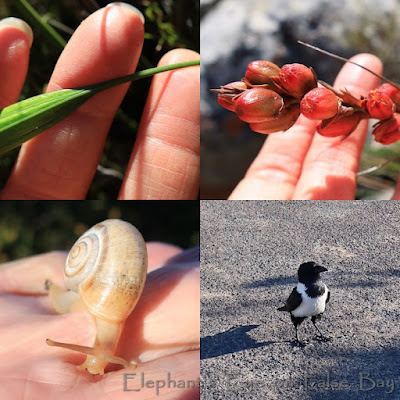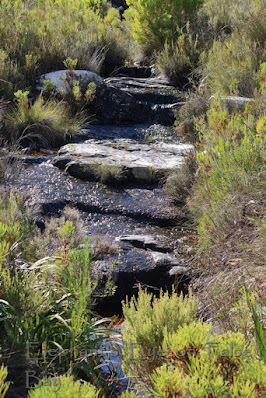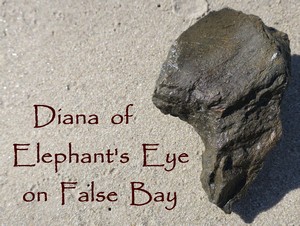May hikes to Elsie's Peak and Silvermine
by Diana Studer
- gardening for biodiversity
in Cape Town, South Africa
Hiking among wildflowers
in the mountains
around Cape Town
We began May on Elsie's Peak. Looking across to Clovelly. The slope covered with felled invasive aliens, waiting for a perfect day suited to stack burning. One day we hope to explore the returning wildflowers there. Puff of green smoke from a naval exercise above Simon's Town.
 |
| Green smoke and cleared invasive aliens |
Weird leaves, when accompanied by fruit, revealed themselves as Tritoniopsis triticea. Fynbos pinwheel snail. This pied crow was determined to approach, has been hand-fed the birders say.
 |
| Elsie's Peak Tritoniopsis, snail, crow |
The only Audouinia capitata we have seen this season. Erica similis with split anthers (you need good eyes, a hand lens, or my zoom on the screen for botanising!) Our friend Teedia lucida is embattled but still surviving (flowers and fruit). Orchid with lichen and Cape lip fern.
 |
| May plants on Elsie's Peak |
Cyclopia galioides 'stick in eye' Eina! Ouch! Butter yellow and burgundy spots Roepera flexuosa. Fire dots lichen
 |
| Elsie's Peak with Cyclopia |
Along Silvermine Crags. IN the cloud, The Tablecloth spread over us. Starring a gloomy Gladiolus maculatus and a glowing scarlet Gladiolus priorii.
 |
| Gladiolus at Silvermine |
Mushroom with delicate gills, accidentally tipped over so we got both sides for an ID, and that touch of blue on the broken stem which seems like a Do NOT Eat warning. Braver mushroom foragers say - and after the pictures, I ate it! (But, you know, not THIS one) Erica glabella. Anaxeton arborescens usually has those pretty and distinctive strawberry buds, but we found this one having a blonde moment.
 |
| May flowers at Silvermine Crags |
Next Maiden Peak in Silvermine. Always just that one Gomphocarpus cancellatus, but this year on the other side of the jeep track. Aristea africana has papery silvery bracts. Amphithalea ericifolia. Strawberry bracts on Metalasia densa.
 |
| Silvermine Maiden Peak May flowers |
Gladiolus maculatus in the gloom as we walked up, but glowing in sunshine by midday.
 |
| Gladiolus maculatus |
We took a different route down to Silvermine stream and across the valley. The water flows over the waterfall. Past the golf club. Down to the wetland - where they are clearing masses of reeds and years of silt accumulation. From where Silvermine River flows across Fish Hoek beach into False Bay. Source to the sea with one small dam used by swimmers.
 |
| Silvermine stream |
My hikes are listed on my page.
I invite you to join us at Elephant's Eye on False Bay. Please subscribe as you prefer
via Feedly,
or my Facebook blog page
Pictures by Diana Studer
of Elephant's Eye on False Bay
Teal blue text is my links.
To read comments if you are in a Reader,
first click thru to the blog)
Thanks for comments that add value. Your comment will not appear until I've read it. I welcome comments on posts from the last 2 months.
Google and Blogger comments uncooperative? Use Name / URL instead.

Some beautiful and fascinating findings. Some of the plants look familiar, but many are new to me. Thanks for sharing all the beauty of your locale during this time of year. Gorgeous Silvermine stream!
ReplyDeleteI'm glad the navy folks used green smoke for their exercise, presumably so as not to alarm residents! The black and white crow has personality. As always I admire the range of interesting flowers you see on your hikes. I love that Gladiolus maculatus, which is very different from the gladiolas I see here.
ReplyDeleteReally enjoyed your hike--I get a sense of the land and botanical wonders from it.
ReplyDeleteWhat sort of invasives are cleared and burnt? Surprised by burning activities, until I remember you are in your winter season.
Mostly Australian wattles. Stacked to dry and shed seeds, then burnt. Then pull seedlings. Persevere till we win! Pines are felled and left to rot down slowly. Both are a fire hazard and water hog, crowding out our indigenous plants. Fynbos burns quick and cool - but the aliens burn hot and destroy our seed bank too. The chosen day is no wind, with rain before, and after.
DeleteAnother beautiful spot. I really love that they have eradicated the invasive and are removing them to allow for natives to continue to flourish. I wish we could have that all over.
ReplyDeleteI love seeing your native gladioli.
ReplyDelete